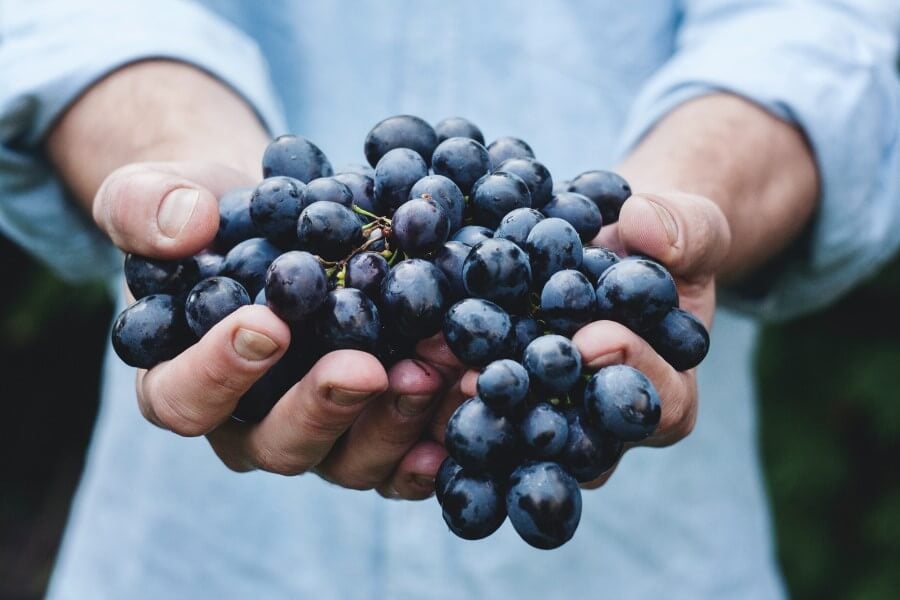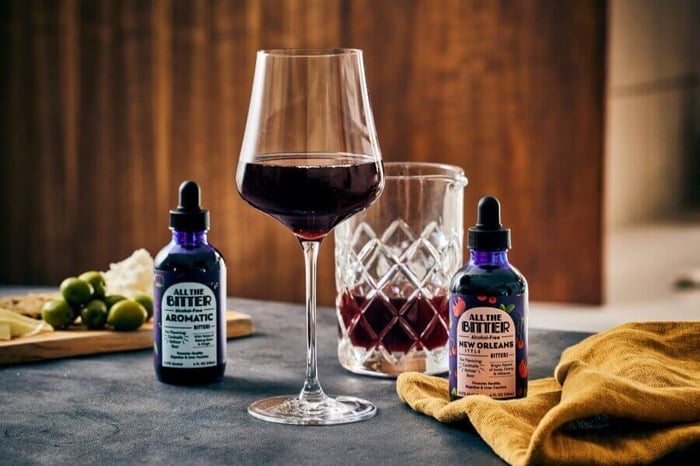Carly and I met working together as sommeliers at The French Laundry—where we were lucky enough to taste the best wines in the world on a nightly basis—so it feels right that the first post on our new blog would be about enjoying non-alcoholic wine. After three years of living happily alcohol-free now, we've tasted most of the de-alcoholized wines on the market, and we've come to a few important conclusions.
- Non-alcoholic wine is wine. It might not taste like the big Napa cab or chardonnay you're used to, but it's not just grape juice.
- There's plenty of enjoyment to be had in non-alcoholic wine, but it requires a change of perspective—you can't remove 15% alcohol and expect the same impact.
- When all else fails, a few "hacks" can greatly improve your experience, especially with red wines (spoiler alert: our alcohol-free bitters are one).
So, you've tasted a few NA wines, and you've been disappointed. We've been there! Luckily, with a few little tweaks, you too can be swirling an earthy yet understated pinot noir, pinky out, while discussing the geopolitical ramifications of cryptocurrency over a lovely duck a l'orange.
But first, let's cover the basics.
Table of Contents

How is Non-Alcoholic Wine Made?
There are two categories of NA wine. Some, like Proxies and Jukes, are composites created from any combination of tart grape juice, tea, bitters, vinegar, herbs, spices, etc. They're meant to simulate the experience of drinking wine, but they're not made from de-alcoholized wine. The other category includes wines like Noughty, Leitz, and YOURS, which start as real, full-proof alcoholic wines. Then, the alcohol is removed through technologies such as reverse osmosis or spinning cone columns. Neither style is right or wrong, but it's helpful to know the difference as you start to taste some of these beverages and develop preferences.
Is Non-Alcoholic Wine Really Alcohol Free?
Non-alcoholic wine, sometimes called dealcoholized wine, is truly non-alcoholic, although it can contain less than 0.5% ABV (alcohol by volume) by definition. Unlike its alcoholic counterparts, it contains negligible to no alcohol content, and any trace amount of alcohol that might remain after dealcoholization is processed by our bodies faster than it can intoxicate us. Crafted to mimic the flavors, varieties, and substance of traditional wine, it provides a delightful experience without the presence of alcohol.
A Change of Perspective
Removing up to 15% alcohol from wine really does a number. So much of the flavor, nuance, and body of wine is tied to that alcohol, and once you strip that, you're left with an entirely different drink. That's why you'll often (but not always) see grape concentrate and natural flavors on the ingredient list. Those additives are used to balance the wine and add back some lost flavor. Think of it like using Photoshop to touch up a blurry photo—it's still wine, but it's been adjusted to compensate for the fact that it had its beating heart ripped from its body, Indiana Jones style. The sooner you can change your perspective and appreciate NA wine for what it is, not what you want it to be, the sooner you'll enjoy it.
Pairing Non-Alc Wine with Food
The right meal can really improve the enjoyment factor with AF wine. Try Luminara's excellent chardonnay with buttery, lemony seafood pasta or Leitz pinot noir with mushrooms and salmon. Is it going to be the same home run pairing you remember? Probably not, but the ritual plays a huge role in appreciation here. On this topic: non-alc wines typically have more residual sugar than alcoholic wines, and while they're constantly getting better in that regard, they'll probably always be sweeter. Use it to your advantage! Spicy food pairs GREAT with sweet wine, and terribly with high alcohol content. Score two points for non-alcoholic wine here! Order some super spicy pad thai, pour yourself a cold glass of NA white wine and enjoy.
Let it Breathe
Alcoholic wine generally gets better with some air, and the same is true of NA wine. We've opened plenty of NA wines that ranged from terrible to simply disjointed—a wine word meaning not harmonious, or out of balance—and with an hour of air, these wines often improve significantly. Better yet, open a bottle the day before you plan to drink it, pour about an ounce out, then stick it in the fridge and come back to it the next day. Remember perspective here, though: no matter how long you let it breathe, it's not suddenly going to taste like that Meiomi pinot noir you've been missing. It is, however, likely to improve things.

Start Adding Stuff
You've changed your perspective, you've let it breathe, and you paired it with the perfect meal, but the wine is still disappointing. Don't fret! We've got one more course of action that can improve things significantly. Most NA wines on the market have things added to them, so what's to stop us from taking it a step further?
Cocktail Bitters
Wine inherently has some bitterness to it, and bitter flavor adds a satisfying "bite" that reminds us we're drinking an adult beverage, not just juice. Cocktail bitters also have a host of flavors that can complement wine without diluting it. Our alcohol-free Aromatic bitters tone down sweetness and add earthy complexity to reds, while our New Orleans bitters lend nice fruity and tart undertones plus bright anise spice. And nearly every white or sparkling wine we drink gets Orange bitters. The amount depends on the wine and your preferences, but anywhere from 1-5 dashes is what we recommend.
Vermouth and Amaro
Vermouth is a fortified wine, so it makes sense that it would play well with other wines. Try a non-alcoholic version like Lyre's Aperitif Rosso in red wines, or Roots Bianco Vermouth in white wine. With a host of complex herbal, bitter, and citrus flavors, vermouth can really enhance the flavor of a dull wine or balance a sweeter wine. The same idea applies to amaro but amped up even more. For a non-alcoholic option, try The Pathfinder, which is distilled from fermented hemp and then infused with botanicals like wormwood, orange peel, and Douglas-fir tips.
Vinegar
Wait, vinegar flavor in wine is a bad thing, right? Typically, yes, but when added a drop at a time to a glass of NA wine, you can add texture, bite, and balance sweetness. Balsamic works great for reds, and white wine vinegar or apple cider vinegar can help brighten up white wines. Averse to vinegar? A simple squeeze of lemon will work the same way.
Make it a Spritz
When all else fails, turn that unsalvageable white wine into a spritz. Add lemon, toss an orange wheel in there, maybe some elderflower syrup, and top it with sparkling water. Red wines are the perfect candidate for sangria made with orange juice, brown sugar syrup, a bit of rum or brandy (non-alcoholic or regular), ALL the muddled fruit, and some soda water.
Not All Wines are Created Equal
We're not going to make any specific recommendations here (that's for another article), but we will say that, in general, white and sparkling wines tend to be more successful than red. With red wines, we often expect big, intense flavors and a full body. That's simply harder to achieve when you strip 15% ABV away. White wines tend towards the more crisp, high-acid spectrum—once you remove the alcohol, you're still left with a satisfying, refreshing sip. Sparkling wines, with their bubbles providing texture, are even more successful.
The Last Sip
You're going to try all of these tricks, and it's still not going to be the same experience as drinking alcoholic wine. It's going to get more interesting and enjoyable, but it's not going to be the same. Remember that you're drinking non-alcoholic wine, and try to enjoy it for what it is.
Cheers! 🍷
-Ian




